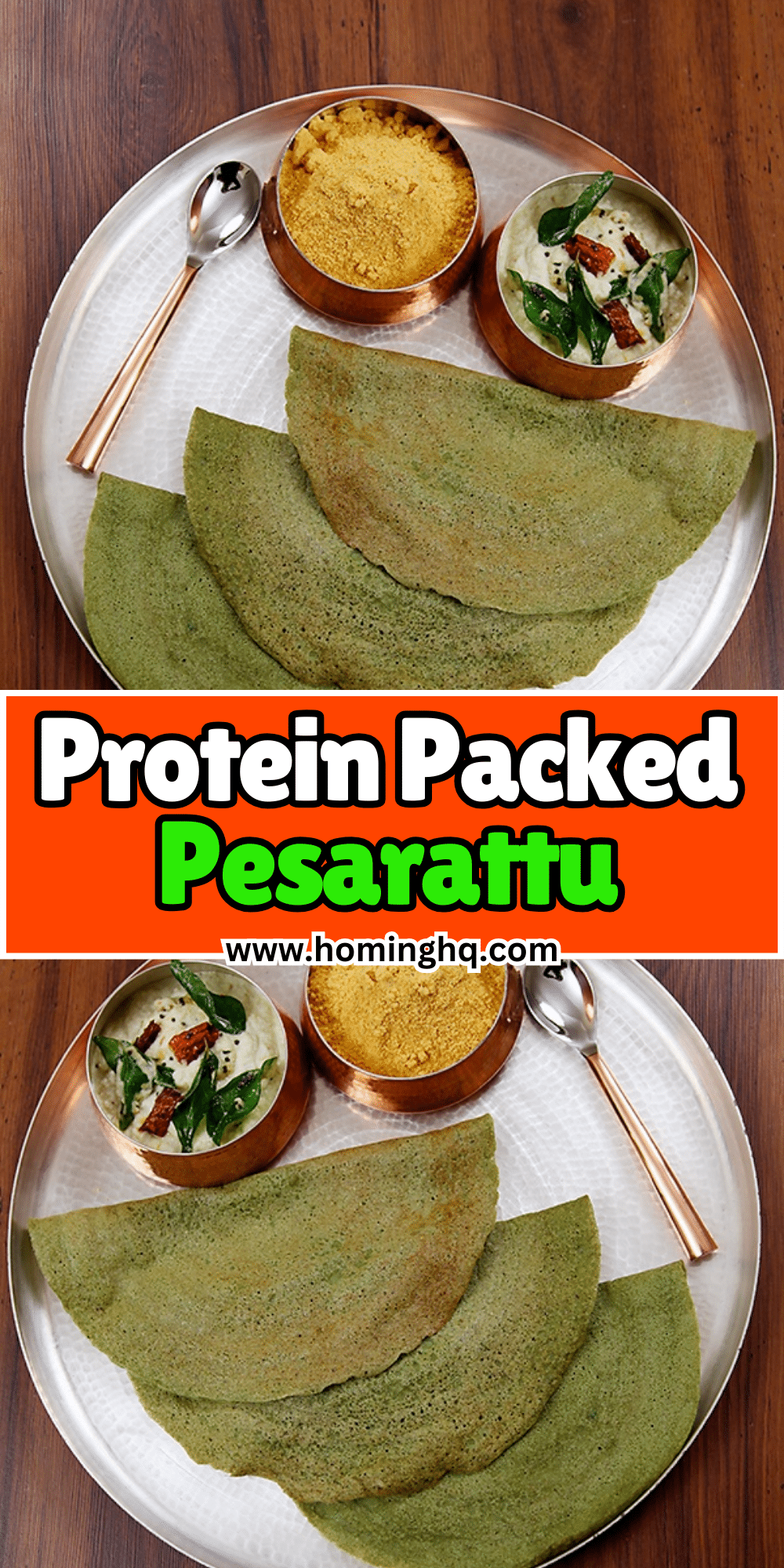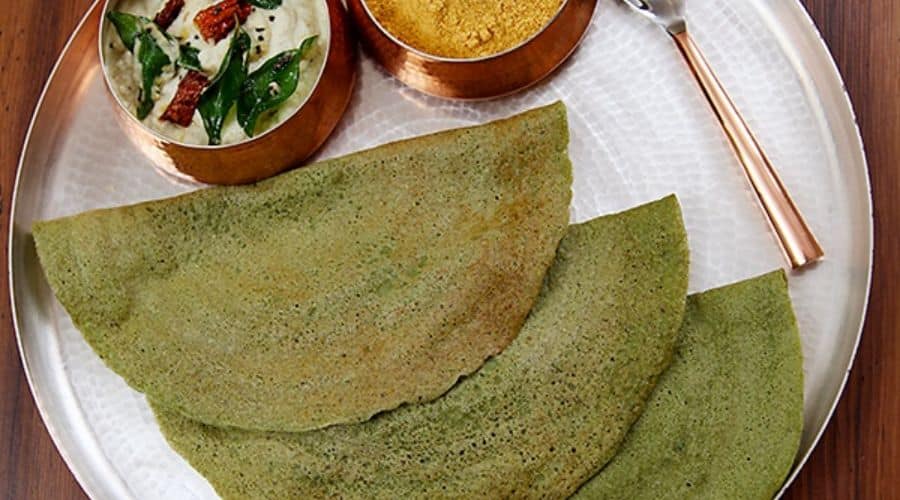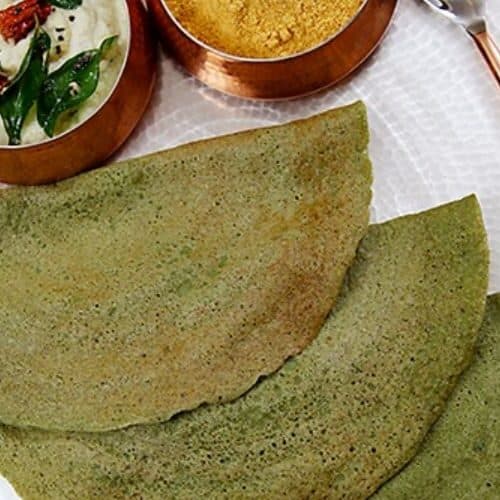Pesarattu is a savory Indian pancake made primarily from green gram (moong dal). Originating from the southern part of India, especially Andhra Pradesh, it is a healthy and flavorful dish often enjoyed for breakfast or as a snack.
The unique texture and taste of Pesarattu come from its combination of soaked green gram, spices, and simple preparation.
Known for being gluten-free and packed with proteins, this dish provides a nourishing start to the day.

What is Pesarattu?
Pesarattu is a traditional South Indian dish made from ground green gram or moong dal. Unlike typical pancakes, it does not require any flour, making it a nutritious alternative.
The dal is soaked, ground, and then fried into crispy, golden-brown pancakes. It is usually served with chutneys such as coconut chutney or ginger chutney, enhancing its flavor.
Pesarattu can also be stuffed with onions, chilies, or other fillings, adding variety to this versatile dish. It is commonly found in Andhra Pradesh and is a popular street food option.
Ingredients for Pesarattu
- Green gram (Moong dal) – 1 cup
- Green chilies – 1-2 (adjust according to taste)
- Ginger – 1-inch piece
- Cumin seeds – 1 teaspoon
- Salt – to taste
- Water – for soaking and grinding
- Oil – for frying
- Chopped onions (optional) – ½ cup
- Coriander leaves (optional) – for garnish
- Curry leaves (optional) – for extra flavor
How to Make Pesarattu

Step 1: Soak the Green Gram
Start by rinsing the green gram (moong dal) thoroughly and then soak it in enough water for about 4-6 hours, or overnight. This step softens the dal and makes it easier to grind.
Step 2: Grind the Ingredients
After soaking, drain the water from the moong dal. Place it in a blender or food processor along with green chilies, ginger, cumin seeds, and a pinch of salt. Add water in small amounts and blend until a smooth, thick batter forms. The consistency should be similar to dosa batter, not too runny.
Step 3: Prepare the Pan
Heat a non-stick tawa or frying pan on medium heat. Once hot, drizzle a little oil to grease the surface.
Step 4: Make the Pesarattu
Pour a ladleful of batter onto the hot pan and spread it in a circular motion to form a thin pancake. If desired, sprinkle some chopped onions, coriander leaves, and curry leaves over the batter to add extra flavor and texture. Let it cook on medium heat until the edges turn golden and crisp.
Step 5: Flip and Cook
Once the edges become crisp, flip the Pesarattu gently to cook the other side. Let it cook for another 2-3 minutes until both sides are evenly golden brown.
Step 6: Serve
Remove the Pesarattu from the pan and serve it hot with coconut chutney or ginger chutney. Enjoy the crispy texture and aromatic taste of this delicious South Indian dish!
Pro Tips for Perfect Pesarattu
1. Soaking the Dal Properly
For the best texture, soak the moong dal for at least 4-6 hours. If you are in a hurry, even 1-2 hours of soaking can work, but longer soaking results in a smoother batter and crispier pancakes.
2. Grinding to the Right Consistency
Make sure the batter is smooth but not too runny. A slightly thicker batter will help the Pesarattu hold its shape and crisp up well on the pan. Add just enough water to blend the dal into a smooth paste.
3. Preheat the Pan Well
Ensure the frying pan or tawa is preheated on medium heat. If the pan is too hot or too cold, the Pesarattu will either burn or remain undercooked. Test by sprinkling a few drops of water on the pan — if it sizzles, it’s ready.
4. Keep the Heat Moderate
Cook the Pesarattu over medium heat. If the heat is too high, it may burn before it cooks through, and if too low, it will become soft and soggy instead of crisp.
5. Use a Non-Stick Pan
A non-stick pan or tawa ensures that the Pesarattu doesn’t stick and can be flipped easily without breaking. It also requires less oil for frying, keeping the dish healthier.
6. Add a Dash of Spice
Feel free to experiment with spices like cumin, black pepper, or even a little asafoetida (hing) to add depth to the flavor. You can also add finely chopped vegetables like carrots or spinach for added nutrition.
Health Benefits of Pesarattu
1. High in Protein
Moong dal is a rich source of plant-based protein, making Pesarattu an excellent option for vegetarians and those looking to increase their protein intake. It helps in building muscle mass and promoting overall body repair.
2. Rich in Fiber
The high fiber content in moong dal helps improve digestion and promotes gut health. Fiber also aids in controlling blood sugar levels, making Pesarattu a good choice for those with diabetes.
3. Gluten-Free
Pesarattu is made entirely from moong dal and is naturally gluten-free, making it suitable for people with gluten intolerance or celiac disease.
4. Supports Heart Health
The moong dal in Pesarattu contains essential amino acids and antioxidants that help in reducing cholesterol levels and supporting heart health. Its low-fat content also contributes to a healthier cardiovascular system.
5. Weight Loss Friendly
Due to its high fiber and protein content, Pesarattu can promote satiety, helping to control hunger and reduce overall calorie intake. It is a great option for those looking to maintain or lose weight.
6. Packed with Vitamins and Minerals
Pesarattu is a good source of vitamins and minerals like potassium, magnesium, iron, and folate. These nutrients play a crucial role in boosting immunity, maintaining bone health, and improving overall well-being.
Serving Suggestions
1. With Coconut Chutney
Pesarattu pairs wonderfully with coconut chutney, which provides a refreshing, slightly sweet contrast to the savory pancake. You can also add a dash of green chilies or tamarind to the chutney for extra flavor.
2. With Ginger Chutney
For those who enjoy a little extra spice, serving Pesarattu with ginger chutney is an excellent choice. The tangy and spicy chutney enhances the dish and brings out the best flavors of the moong dal.
3. Stuffed Pesarattu
For a more filling meal, stuff the Pesarattu with sautéed vegetables like onions, carrots, or spinach. You can also add some paneer (Indian cottage cheese) for extra protein. This makes for a satisfying and nutritious dish.
4. With Yogurt
For a creamy and cooling accompaniment, serve Pesarattu with a side of plain yogurt. The yogurt adds a mild tanginess that complements the spiciness of the Pesarattu.
5. As a Snack
Pesarattu can also be served as a snack, cut into smaller pieces and paired with a tangy tamarind dip or coriander chutney. It’s a great finger food for gatherings or tea-time.
Conclusion
Pesarattu is a delightful and healthy South Indian dish that brings the goodness of moong dal in a crispy and savory pancake form. It is easy to make, packed with nutrients, and incredibly versatile in terms of flavoring and pairing. Whether you enjoy it for breakfast, as a snack, or even as a meal, it offers a delicious and wholesome option. With the right balance of spices and accompaniments, Pesarattu will surely become a favorite in your culinary repertoire.
Frequently Asked Questions (FAQs)
1. Can I make Pesarattu without onions?
Yes, you can make Pesarattu without onions. The recipe is very flexible, and you can skip the onions if you prefer a simpler version. You can also add other vegetables like carrots or spinach for added nutrition.
2. How long can I store leftover Pesarattu?
Leftover Pesarattu can be stored in an airtight container for up to 1-2 days in the refrigerator. To reheat, you can place it on a tawa or grill pan to restore its crispiness.
3. Can I freeze Pesarattu batter?
Yes, you can freeze Pesarattu batter for up to a month. Make sure to store it in an airtight container or a zip-lock bag. When ready to use, thaw the batter and stir it well before cooking.
4. Can I use split moong dal instead of whole green moong dal?
Yes, you can use split moong dal (yellow moong dal) instead of whole green moong dal, though the texture and flavor may vary slightly. It will still give you a similar result but with a softer texture.
5. Can Pesarattu be made spicy?
Absolutely! You can adjust the level of spiciness by increasing the number of green chilies in the batter or adding red chili powder. For extra heat, serve it with spicy chutneys like ginger chutney or garlic chutney.

Pesarattu
Equipment
- Blender or Food Processor – 1
- Frying Pan (Tawa) – 1
- Ladle – 1
- Measuring cups and spoons (1 set)
- Knife (1)
- Chopping Board – 1
Ingredients
- Green moong dal – 1 cup
- Green chilies – 1-2 adjust according to taste
- Ginger – 1-inch piece
- Cumin seeds – 1 teaspoon
- Salt – to taste
- Water – as needed for soaking and grinding
- Oil – for frying about 1 tablespoon per pancake
- Chopped onions optional – ½ cup
- Coriander leaves optional – for garnish
- Curry leaves optional – for extra flavor
Instructions
oak the Green Moong Dal:
- Rinse the moong dal thoroughly and soak it in water for 4-6 hours or overnight.
Grind the Ingredients:
- Drain the soaked moong dal and blend it with green chilies, ginger, cumin seeds, and salt. Add small amounts of water to form a smooth, thick batter.
Heat the Pan:
- Preheat a non-stick frying pan or tawa on medium heat. Drizzle a little oil to grease the surface.
Cook the Pesarattu:
- Pour a ladleful of batter onto the pan and spread it evenly in a circular shape. Optionally, sprinkle chopped onions, coriander leaves, and curry leaves on top. Cook for 2-3 minutes until the edges are golden and crisp.
Flip and Cook the Other Side:
- Flip the Pesarattu gently and cook for another 2-3 minutes until golden brown on both sides.
Serve:
- Serve the Pesarattu hot with chutney, yogurt, or a filling of your choice.
Notes
- For a spicier version, increase the number of green chilies or add red chili powder to the batter.
- If you prefer a smoother texture, grind the dal for a longer time to make the batter finer.
- You can stuff the Pesarattu with sautéed vegetables like carrots, onions, or spinach to add more flavor and nutrition.
- The batter can be stored in the refrigerator for up to 1 day or frozen for up to a month.
- You can also make mini Pesarattus for snacks or parties, adjusting the cooking time accordingly.

